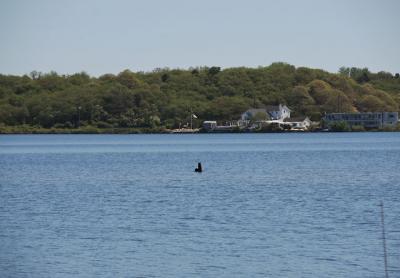Nature Notes: It’s the Water, Man!

Last Thursday afternoon I had the good (bad?) fortune of being in Montauk. I had heard the talk about moving the downtown (to where, I wonder), putting in a sewage treatment plant (where would the outfall go, I wonder), ospreys coming back to nest, and the like.
Montauk looked solid enough, however, and I began to think that overstatement was the likely cause of so much concern.
That optimistic overview was suddenly wiped away, however, when I turned onto Industrial Road from Flamingo Avenue, then onto Second House Road. What happened to Brushy Island? The only sign of it remaining in Fort Pond was a single stump sticking up about a foot above the surface. The rest of it had completely disappeared from view. Uh-oh, I thought, not only is the second largest freshwater pond on Long Island plagued with blue-green algae, it had reached a record-high water level. Given a big coastal storm with lots of rain and wind, the pond will be splashing onto Industrial Road and into the buildings across the street.
It’s hard to imagine that less than 100 years ago, Brushy Island was doing fine. The botanist Norman Taylor had written about the American basswood tree growing on it, the only one he found among the hundreds of native plants he discovered in the whole of Montauk in the 1920s. The island is still visible on the Google satellite map for Montauk, but only as a vague shadow.
If only the town had trenched under the Long Island Rail Road tracks and installed a conduit to Fort Pond Bay to reduce the pond’s water level before damages to the generator station and massive battery-to-be could be avoided. The two main high-tension electrical cables serving Montauk, which once ran from the Long Island Power Authority’s Amagansett substation on steel poles across Napeague, are now buried along the north shoulder of Route 27. The two lines leave 27, course through Hither Woods to the nexus of Second House and Industrial Roads and then onto the National Grid station on the north side of Fort Pond.
In fact, before the Long Island Rail Road was extended to Montauk at the turn of the 19th century, Fort Pond used to be regularly sea-poosed to Fort Pond Bay so that fish, including alewives, could move back and forth between bay and pond for spawning and feeding purposes. Alewives have been missing for more than 100 years, but the freshwater clams that still survive in the pond owe their lives to them. The larvae from their spawning would attach themselves to the alewives’ gills and ride out to sea with them at the end of summer.
Freshwater clams also reside in Big Fresh Pond in North Sea, which still plays host to an annual coming and going of breeding alewives and their young via North Sea Harbor. I would imagine that those ones in Fort Pond at its north end could be 100 or more years old. I have yet to find a little one amongst them. Hard clams, or quahogs, can live to be centenarians, why not closely related freshwater clams too?
There are several explanations for Fort Pond’s inevitable rise. Fresh groundwater that fills the pond rides on top of salt water because it is less dense than the latter and is buoyed up by it. As sea level rises — more than a foot since the railroad was extended to Montauk — the fresh water on top rises commensurately. Because Montauk’s groundwater is shallow in thickness and sullied here and there, there is not enough good water to supply Montauk’s potable needs.
Since the 1990s Montauk has been receiving supplementary fresh potable water from Suffolk County Water Authority wells west of Napeague by way of an underground water main, the same main that provides water to the motels, restaurants and houses along the Napeague stretch. After the Water Authority’s water leaves the motels, restaurants, businesses, and residences by way of septics it becomes part of the groundwater regime, most, but not all, of which flows out to sea on both sides of the Montauk peninsula. Thus there is an additional slow but steady rise in the elevation of Montauk’s freshwater water table as reflected in Fort Pond’s rise. A drought, such as that experienced by Long Island in the 1960s, could reverse this process, but only for a little while.
A downtown sewage treatment plant discharging spent water into the ocean (or Block Island Sound) by way of an outfall pipe would slow this rise somewhat, but what would all that wastewater do to the surrounding marine waters?
Montauk is just the tip of the iceberg as far as the South Fork and the rest of Long Island are concerned. Has anyone actually run the numbers? Are there enough pure, fresh groundwater reserves in the Upper Glacial, Magothy, and the Lloyd aquifers to suit Long Island’s ambitious thirst for development? I very much doubt it. Two hundred units here, five hundred there, a new hotel here, new motels there, thousands more single family residences, the Ronkonkoma hub, Nassau Coliseum, the Sayville retirement community. I could go on and on. There is simply not enough potable water under our feet to suit the developers’ and builders’ current and future appetites, which only grow larger and larger as we get bigger and more populous.
Long Island is loaded with planners and different committees that investigate our future water needs and publish annual reports, but there is no getting around it: If we continue to develop at the pace we read about every day in Newsday, we are destined to go the way of countless villages, towns, cities, and, even, civilizations that depended on fresh potable water, but ran out of it instead.
Larry Penny can be reached via email at [email protected].
